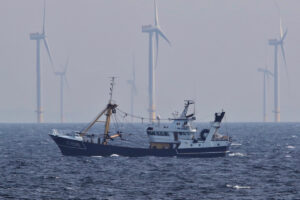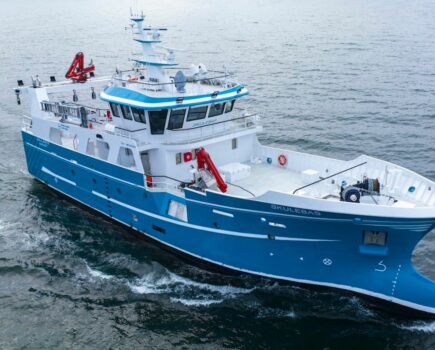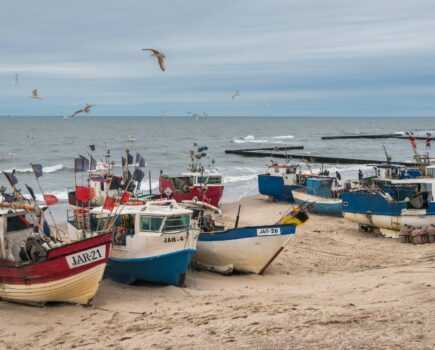Percentage paid to Crown could reduce, as developers warn of rising costs
Wind farms in English and Welsh waters have driven a rapid increase in profits for the Crown Estate, which in principle is the property of the UK monarch.
As well as a swathe of high-end properties in London and large land holdings, most of the seashore and UK seabed is nominally held in the name of the king, for which he receives rents.
The value of the estate has ballooned in recent years, as the offshore leasing bonanza has kicked in, with a book value that has increased to £15.8bn, producing a rental profit after expenses last year of £443m.

The Belgian beamer Mooie Meid Z-296 passing turbines in Morecambe Bay, where leases for three new sites have recently been confirmed. (Photo: Darren Purves)
This income does not include any wind farm revenue generated in Scottish waters, which goes direct to the Scottish government. The last round of leases auctioned off by Crown Estate Scotland saw total revenue of £700m over the lifetime of the projects – a figure that many analysts suggest was well below the market rate, and a real bargain for offshore developers there.
The record-breaking profits in England and Wales are leading to a recalculation of the percentage that is paid to the Royal Household, currently 25%. The current rental profit is widely expected to increase in future years as additional revenue from offshore developers kicks in.
The king suggested earlier in the year that he could somehow get by on a smaller percentage, and that he would like to see the additional revenue used ‘for the wider good’.
Dan Labbad, the crown estate’s chief executive, said the record return to the Treasury generated by offshore wind farms reflected ‘the immense amount of groundbreaking work’ the estate had undertaken ‘to create a world-leading offshore wind market’.
Income is set to increase significantly, with six new leases recently confirmed – three in and around the Morecambe Bay gas field, and three in the North Sea: two on the Dogger Bank, and a third on the Inner Dowsing.
In addition, sites in the Celtic Sea, the English Channel and the Thames estuary are in the planning stages.
Several wind companies, however, have cautioned that financial arrangements for developers in English and Welsh waters put some of the projects at risk. Whilst current operators are benefiting from much
higher than predicted wholesale electricity prices, boosting profitability, a projected fall over the coming years is, say some developers, a disincentive to further building.
Companies such as Ørsted have bid for contracts based on a guaranteed minimum payment for their electricity, the so-called ‘contract for difference’, where the government would step in and guarantee a unit price if the market rate falls below this.
In order to secure the contracts on offer, several developers are thought to have bid lower than may be viable, and are now believed to be having second thoughts about completing wind farm investments. The shortfall is said to be due to a worldwide shortage of wind turbine components, pushing up prices, and significant increases in borrowing costs.
This story was taken from the latest issue of Fishing News. For more up-to-date and in-depth reports on the UK and Irish commercial fishing sector, subscribe to Fishing News here or buy the latest single issue for just £3.30 here.
Sign up to Fishing News’ FREE e-newsletter here.








